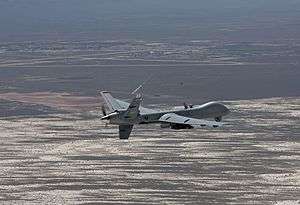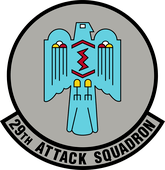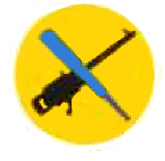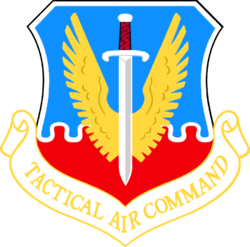29th Attack Squadron
29th Attack Squadron
 | |
|---|---|
 MQ-9 Reaper inflight over Holloman AFB | |
| Active | 1942–1946; 1954–1971; 2009–preent |
| Country |
|
| Branch |
|
| Role | Remote Piloted Aircraft operations |
| Part of | Air Combat Command |
| Garrison/HQ | Holloman Air Force Base |
| Decorations | Air Force Outstanding Unit Award[1] |
| Insignia | |
| 29th Attack Squadron emblem (approved 12 December 1956)[1] |
 |
| 13th Observation Squadron emblem[2] |
 |
The 29th Attack Squadron is an active United States Air Force training unit flying the General Atomics MQ-9 Reaper. It is assigned to the 49th Operations Group at Holloman Air Force Base, New Mexico. It was activated on 23 October 2009.
History
World War II
Established in early 1942 as an observation squadron; trained under Third Air Force in the southeast. Equipped with the P-39F-2 Airacobra variant which was capable of both ground-attack and reconnaissance missions. Functioned primarily as a training unit during World War II, providing training of reconnaissance pilots and also supporting various Army training units at Fort Polk, Fort Campbell and also the Desert Training Center in Southern California. Also flew P-40F Warhawks also equipped for reconnaissance missions. Remained in active service after the war ended as a North American F-6 Mustang night reconnaissance squadron, but inactivated in 1946 as part of the general demobilization of the USAAF.
Cold War tactical reconnaissance
Reactivated in 1954 under Tactical Air Command and equipped with RF-80A Shooting Stars at Shaw AFB, South Carolina. Performed training of reconnaissance pilots; being upgraded to the Republic RF-84F Thunderflash in 1955 and the McDonnell RF-101C Voodoo in 1957 as a component of the 432d Tactical Reconnaissance Group. Remained at Shaw when the 432d was inactivated and reassigned to the 363d Tactical Reconnaissance Wing.
Equipped with the McDonnell RF-4C Phantom II due to a critical need for reconnaissance pilots due to the Vietnam War. Performed training on the RF-4C until 1971 when inactivated due to the USAF drawdown in Vietnam and budget reductions.
Remotely Piloted Vehicle operations
On 23 October 2009, the 29th Attack Squadron stood up under the 49th Wing at Holloman Air Force Base, New Mexico under the command of Lt Colonel James S. Merchant. An initial cadre of twelve instructors (six Instructor Pilots and six instructor sensor 0perators) manned the unit. The unit replaced the 432d Operations Group, Detachment 3.[3] It is a General Atomics MQ-9 Reaper Formal Training Unit.
Lineage
- Constituted as the 13th Observation Squadron (Medium) on 5 February 1942
- Activated on 10 March 1942[4]
- Redesignated 13th Observation Squadron on 4 July 1942
- Redesignated 13th Reconnaissance Squadron (Fighter) on 1 April 1943[5]
- Redesignated 13th Tactical Reconnaissance Squadron on 11 August 1943
- Redesignated 29th Reconnaissance Squadron (Night Photographic) on 25 January 1946
- Inactivated on 29 July 1946
- Redesignated 29th Tactical Reconnaissance Squadron (Photographic-Jet) on 14 January 1954
- Activated on 18 March 1954
- Redesignated 29th Tactical Reconnaissance Squadron and activated on 1 October 1966
- Inactivated 24 January 1971
- Redesignated 29th Attack Squadron on 20 October 2009
- Activated on 23 October 2009[1]
Assignments
- 74th Observation Group (later 74th Reconnaissance Group, 74th Tactical Reconnaissance Group), 2 March 1942
- XIX Tactical Air Command, 7 November 1945 (attached to 69th Reconnaissance Group)
- 69th Reconnaissance Group, 25 January–29 July 1946[6]
- 432d Tactical Reconnaissance Group, 18 March 1954
- 432d Tactical Reconnaissance Wing, 8 February 1958 (attached to 363d Tactical Reconnaissance Wing after 8 April 1959)
- 363d Tactical Reconnaissance Wing, 18 May 1959
- 4403d Tactical Training Group, 1 July 1966
- 363d Tactical Reconnaissance Wing, 20 January 1968 – 24 January 1971
- 49th Operations Group, 23 October 2009 – present[1]
Stations
|
|
Aircraft
- Curtiss O-52 Owl, 1942-1943
- Piper L-4 Cub, 1942-1943;
- Bell P-39 Airacobra, 1943-1944
- Curtiss P-40F Warhawk, 1944-1945
- North American P-51 Mustang, 1945-1946
- North American F-6 Mustang, 1945-1946
- Douglas A-26 Invader, 1946
- Lockheed RF-80A Shooting Star, 1955
- Republic RF-84F Thunderflash, 1955-1958
- McDonnell RF-101C Voodoo, 1957-1971
- McDonnell RF-4C Phantom II, 1968-1971
- General Atomics MQ-9 Reaper, 2009-present[1]
References
- Notes
- 1 2 3 4 5 6 Kane, Robert B. (May 18, 2017). "Factsheet 29 Attack Squadron (ACC)". Air Force Historical Research Agency. Retrieved September 2, 2017.
- ↑ Hubbard, p. 719
- ↑ Escutia, A1C Sondra (October 8, 2009). "MQ-9 Reaper makes first local flight". Air Force Print News Today. Archived from the original on March 12, 2012. Retrieved September 3, 2017.
- ↑ Maurer says 2 March 1942. Maurer, Combat Squadrons, pp. 74-75
- ↑ Maurer says 2 April 1942. Maurer, Combat Squadrons, pp. 74-75
- ↑ Maurer says assignment began 18 February. Maurer, Combat Squadrons, pp. 74-75
Bibliography
![]()
- Hubbard, Gerardl (1943). "Aircraft Insignia, Spirit of Youth". The National Geographic Magazine. National Geographic Society. Vol. LXXXIII (No. 6): 718–722. Retrieved September 1, 2017. (subscription required for web access)
- Maurer, Maurer, ed. (1983) [1961]. Air Force Combat Units of World War II (PDF) (reprint ed.). Washington, DC: Office of Air Force History. ISBN 0-912799-02-1. LCCN 61060979. Retrieved December 17, 2016.
- Maurer, Maurer, ed. (1982) [1969]. Combat Squadrons of the Air Force, World War II (PDF) (reprint ed.). Washington, DC: Office of Air Force History. ISBN 0-405-12194-6. LCCN 70605402. OCLC 72556. Retrieved December 17, 2016.
- Ravenstein, Charles A. (1984). Air Force Combat Wings, Lineage & Honors Histories 1947-1977 (PDF). Washington, DC: Office of Air Force History. ISBN 0-912799-12-9. Retrieved December 17, 2016.
External links
- Staff writer, no byline (August 25, 2011). "MQ-9 sustains damage during landing". U.S. Air Force Public Affairs. Retrieved September 3, 2017.
- The Official Home Page of the U.S. Air Force
- http://www.shephard.co.uk/news/4168/reaper-takes-flight-at-holloman/%5Bdead+link%5D
- https://web.archive.org/web/20110927153214/http://www.holloman.af.mil/news/story.asp?id=123177365
- On Intellipedia
